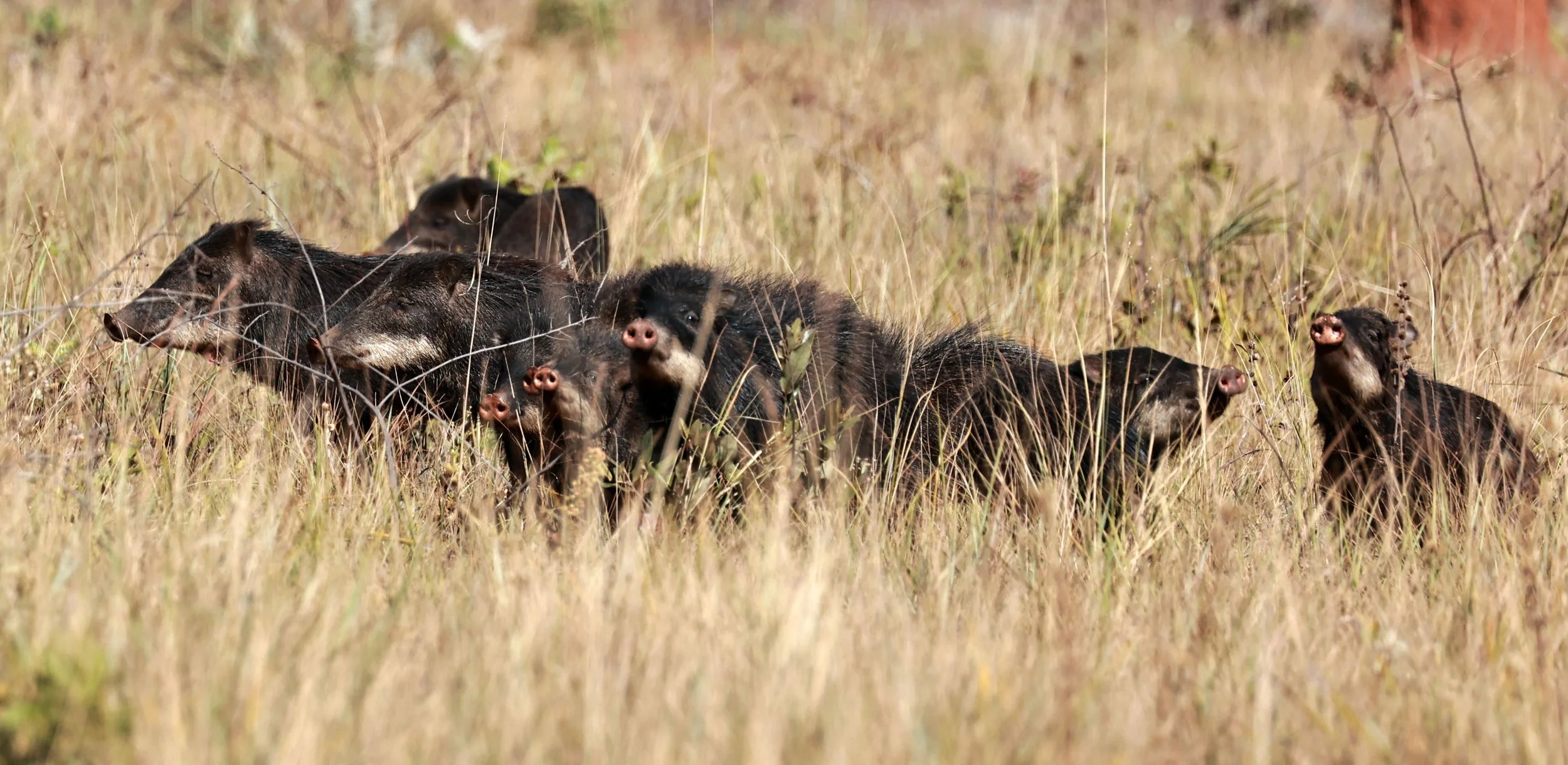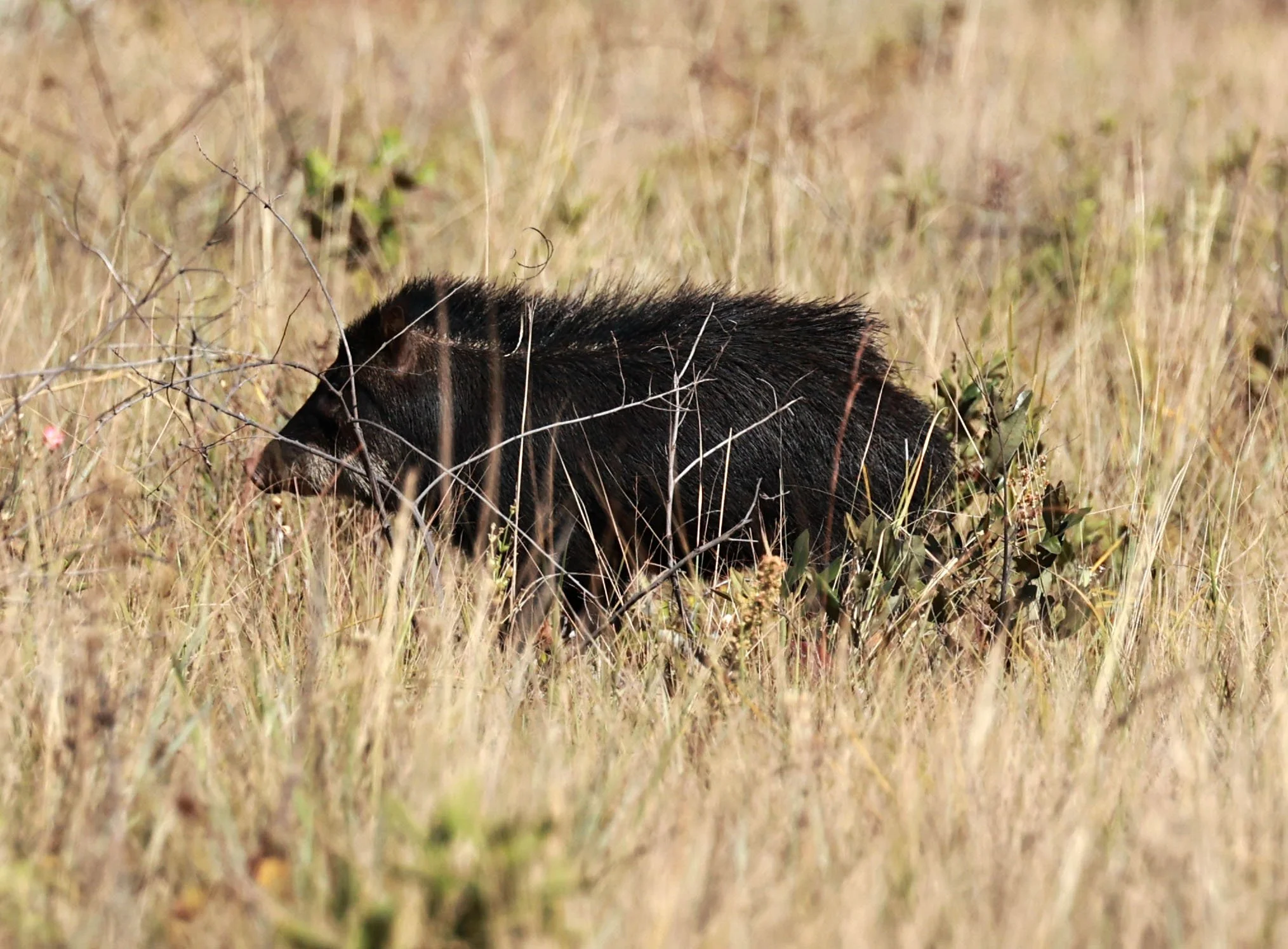
White-lipped Peccary (Tayassu pecari)
The White-lipped Peccary (Tayassu pecari) is a species of peccary found in Central and South America and the only member of the genus Tayassu. Multiple subspecies have been identified. White-lipped peccaries are similar in appearance to pigs, but covered in dark hair (except on certain regions, such as the throat, where it is cream). The range of T. pecari, which extends from Mexico to Argentina, has become fragmented, and the species's population is declining overall (especially in Mexico and Central America). They can be found in a variety of habitats. Social animals, white-lipped peccaries typically forage in large groups, which can have as many as 300 peccaries.
They are an important part of their ecosystem and multiple efforts are being made to preserve them in the wild. Not all disappearances are explained, but human activities play a role, with two major threats being deforestation and hunting; the latter is very common in rural areas, although it can be dangerous, as white-lipped peccaries can be aggressive. They are hunted for both their hide and meat.
The white-lipped peccary was first described by Johann Heinrich Friedrich Link in 1795 as Sus pecari. It was moved into the monotypic genus Tayassu by Gotthelf Fischer von Waldheim in 1814.
There are five recognized subspecies:
T. p. pecari (Link, 1795)
T. p. aequatoris (Lönnberg, 1921)
T. p. albirostris (Illiger, 1815)
T. p. ringens (Merriam, 1901)
T. p. spiradens (Goldman, 1912)
The fossil record of T. pecari is limited. It has existed since at least the Pliocene. Fossils from the Late Pleistocene suggest a different distribution during this time, being mostly found in more southern areas (such as the Buenos Aires Province of Argentina). Based on the other species that coexisted with it during this period, the central-northern Buenos Aires Province was likely arid or semi-arid in the Late Pleistocene.
White-lipped Peccary in Emas National Park, Goias.
The white-lipped peccary is capable of producing offspring with the collared peccary (Dicotyles tajacu), another member of the peccary family. This has been recorded at the London Zoo and Manaus Zoo, but never in the wild.
The white-lipped peccary is a piglike ungulate, covered in dark hair, which is cream on certain parts of the underside, such as the throat and pelvic regions. Adult white-lipped peccaries can reach a length of 90–135 cm (35–53 in). Their height is about 90 cm (35 in), measured from the shoulder. They usually weigh 27–40 kg (60–88 lb), but can grow even larger. There is no obvious sexual dimorphism, but males have longer canine teeth than females. They possess a scent gland, which is found at the posterior middorsal region.
The white-lipped peccary is native to Argentina, Belize, Bolivia, Brazil, Colombia, Costa Rica, Ecuador, French Guiana, Guatemala, Guyana, Honduras, Mexico, Nicaragua, Panama, Paraguay, Peru, Suriname, and Venezuela. It is regionally extinct in El Salvador. White-lipped peccaries thrive in dense, humid, tropical forests. They can also be found in a wide range of other habitats, such as dry forests, grasslands, mangroves, and dry xerophytic areas, as well as the Cerrado ecoregion of Brazil. They range from sea level to an altitude of 1,900 m (6,200 ft). Their range overlaps with that of the collared peccary.
A 2018 study found that they had disappeared from 87% of their historical range in Mesoamerica (which the study defined as everywhere between southern Mexico and Panama), and were in "critical condition" in the seven Mesoamerican countries they still inhabited. Studies by the International Union for Conservation of Nature found similar information, with a reported decline of 89% in Costa Rica and 84% in Mexico and Guatemala.
White-lipped peccaries generally move from place to place in large herds. Unlike D. tajacu, which travels single-file, T. pecari moves in broad groups.[5] Group sizes can range from under ten (while uncommon, groups as small as five have been recorded) to as many as 300. Especially large groups are rarer now than they were historically, due to the declining population of T. pecari. The average group size in a fragmented area of the Atlantic Forest was found to be around 42, although herds frequently come into contact with one another and interbreed. Juvenile peccaries have been found to make up no more than 20% of herds in studies.
As mentioned previously, the range of T. pecari overlaps with that of D. tajacu. This overlap is significant, with both found in similar habitats across the Neotropics. A study published in 1982 found that the former's bite force is at least 1.3 times as great as that of the collared peccary. This may help to explain how the two manage to coexist over such a large area, as the study also found that they consumed different kinds of seeds and nuts when foraging in the same area. The measured resistance of these seeds and nuts was found to be consistent with the bite forces of the two peccary species.
They can produce screaming noises and clack their teeth when they travel in herds, which allows them to be heard from hundreds of meters away facilitating “group coherence” and intimidating potential predators. In common with other peccaries, GBIF writes that "their vocal repertoire includes low-frequency barking, growling, moaning, high-pitched squealing, and tooth clacking."
White-lipped peccaries forage for food, frequently doing so in coastal areas or near other bodies of water. Most of their diet is made up of fruit, although it is supplemented with additional foods, such as other parts of plants (which can include nuts), fungi, invertebrates (including snails), and even fish on occasion. They consume over 140 different species of plants from over 30 families across their range. While not as frequently, they are also known to feed on earthworms, eggs, small vertebrates, and carrion.
White-lipped peccaries are an important prey for large felines. When in large groups they can—and have been known to—drive away jaguars with their loud vocalizations.







































































































































